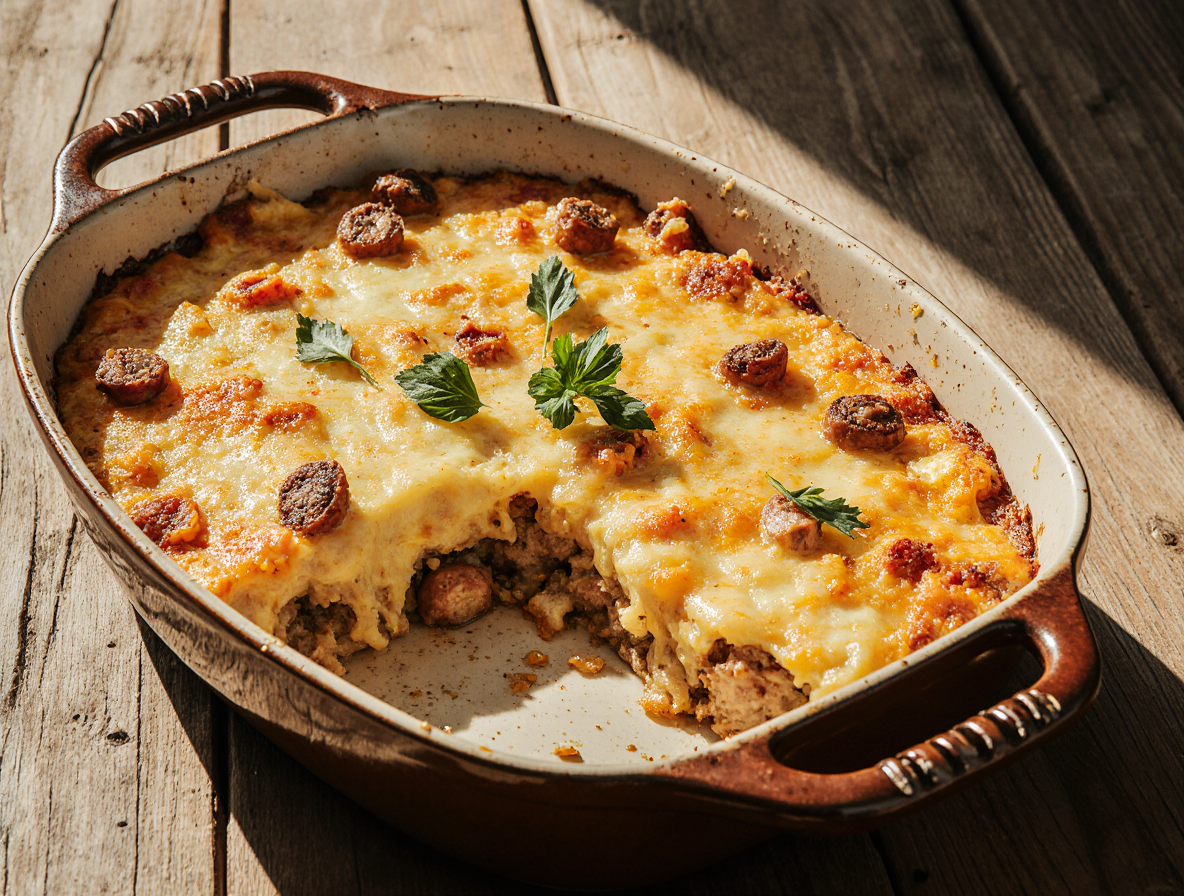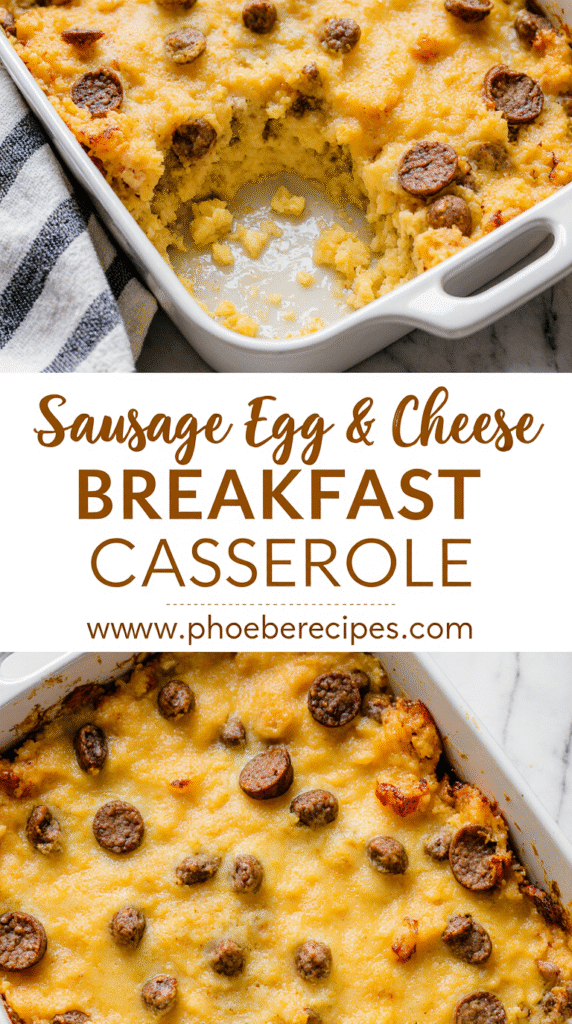The Perfect Sausage and Egg Casserole Without Bread (Easy 30-Minute Recipe)
Craving a hearty breakfast without the carbs? Our sausage and egg casserole without bread takes less than an hour to make and has become one of the most popular recipes for good reason. I love how this dish offers the perfect combination of convenience and flavor while keeping carbs to a minimum.
This egg sausage casserole no bread recipe is surprisingly versatile. With just 4 total carbs per serving, it’s perfect for those following a keto lifestyle. Additionally, this high-protein breakfast option packs an impressive 24 grams of protein per serving, keeping you satisfied for hours. What makes this easy sausage and egg casserole without bread even more appealing is its flexibility – you can certainly prep it the night before or even enjoy it as a “breakfast for supper” meal.
In this guide, I’ll walk you through everything you need to know about creating the perfect sausage egg and cheese casserole without bread – from essential ingredients to step-by-step instructions, storage tips, and creative variations. Whether you’re feeding a crowd at a holiday brunch or meal prepping for your busy week ahead, this recipe can easily be doubled to serve more people.
Essential Ingredients for a Bread-Free Casserole
Creating the perfect sausage and egg casserole without bread starts with selecting the right ingredients. Let’s explore what makes this dish shine without relying on bread for structure or flavor.
Choosing the right sausage
The foundation of a flavorful egg casserole begins with the sausage. Hot Italian sausage adds subtle spiciness and richly flavors the egg mixture. For a traditional breakfast taste, regular pork breakfast sausage works beautifully – brands like Jimmy Dean and Swaggerty are popular choices. You’ll typically need about 1 pound of sausage for a standard casserole. Furthermore, you can experiment with chicken or turkey sausage for a leaner option, or try chorizo for a bolder flavor profile.
How many eggs to use
Eggs form the heart of your casserole. Most recipes call for 10-12 eggs, though some use as few as 8. A helpful guideline is to estimate 2 eggs per person you’re serving. When seasoning, remember this simple ratio: add 1/2 teaspoon kosher salt for every 4 eggs to achieve perfect flavor balance.
Best cheese options
Cheese adds richness and helps bind your casserole together. Sharp cheddar brings a tangy flavor that complements the sausage perfectly. Gruyère or Fontina (approximately 4 ounces for 12 eggs) offer sophisticated flavor notes. Monterey Jack melts beautifully, creating that desirable stretchy texture. If you prefer something with a kick, pepper jack is an excellent alternative.
Optional veggies to add flavor
Vegetables not only enhance nutrition but also add texture and color. Spinach is particularly popular because it requires no pre-cooking – simply toss it with hot sausage and onions to wilt it naturally. Bell peppers (red, orange or green) contribute sweetness and vibrant color. Other excellent additions include mushrooms, broccoli, asparagus, or tomatoes. To save time, consider using frozen vegetables that don’t require chopping.
Dairy alternatives for milk or cream
Adding dairy creates a more custardy texture. Half and half or heavy cream makes the eggs more forgiving and less likely to become rubbery when baked. For lighter options, whole milk works well. Those avoiding dairy can substitute unsweetened almond milk, rice milk, or coconut milk without compromising texture. Alternatively, sour cream, Greek yogurt, or softened cream cheese can replace traditional dairy for added richness and protein.
Step-by-Step: How to Make the Perfect Sausage and Egg Casserole Without Bread
Now let’s dive into the cooking process! Making a delicious sausage and egg casserole without bread requires just a few simple steps that anyone can master.
1. Preheat and prep your baking dish
First, preheat your oven to 350°F (175°C). Meanwhile, grab a 9×13-inch baking dish and generously grease it with butter or cooking spray. This prevents sticking and helps the casserole develop a nice golden edge. The right preparation ensures your casserole will release easily when serving.
2. Cook sausage and vegetables
In a large skillet over medium-high heat, cook your sausage until browned, breaking it into small pieces as it cooks. This typically takes about 7-9 minutes. Once browned, remove excess fat. Subsequently, in the same pan, add your chosen vegetables (onions, peppers, mushrooms) and sauté until softened, usually 5-7 minutes. The vegetables should be tender but not mushy.
3. Whisk eggs, cheese, and seasonings
In a large bowl, thoroughly whisk your eggs until smooth and uniform in color. Next, add salt, pepper, and any additional seasonings like garlic powder or Italian herbs. Stir in your preferred cheese (reserving some for topping if desired) and a splash of milk or cream for richness and fluffiness.
4. Combine and pour into dish
Once the sausage and vegetable mixture has cooled slightly, add it to your egg mixture and stir until everything is evenly distributed. This ensures every bite contains all the flavors. Afterward, pour the entire mixture into your prepared baking dish, spreading it evenly.
5. Bake and check for doneness
Place the casserole in your preheated oven and bake uncovered for 25-35 minutes. The casserole is done when the edges are set, the top is slightly golden, and the center is just barely jiggly. For absolute certainty, insert a knife into the center – it should come out clean. Alternatively, use a food thermometer to confirm the internal temperature has reached 160°F.
Make-Ahead, Storage, and Reheating Tips
One of the greatest advantages of this sausage and egg casserole without bread is its make-ahead potential. Let me share how to maximize convenience without sacrificing quality.
How to prep the night before
For busy mornings, prepare your egg sausage casserole no bread the evening before. Simply assemble all ingredients through the combining step, cover tightly with plastic wrap, and refrigerate for at least 8 hours and up to 24 hours. This overnight rest allows flavors to meld beautifully. Moreover, some chefs recommend a minimum 30-minute refrigeration before baking if you’re short on time.
Storing leftovers in the fridge
Once cooled completely, store your leftover casserole in an airtight container. Properly stored, your easy sausage and egg casserole without bread will remain fresh in the refrigerator for 3-4 days. Essentially, cooling before storage prevents condensation that could make the casserole soggy.
Freezing individual portions
This casserole freezes exceptionally well! For individual servings, wrap cooled portions in damp paper towels, place in ziplock bags, and freeze for up to 2-3 months. Alternatively, freeze the entire unbaked casserole by covering tightly with plastic wrap followed by aluminum foil. When ready to use, thaw overnight in the refrigerator before baking according to recipe instructions.
Best ways to reheat without drying out
To maintain moisture when reheating your sausage egg and cheese casserole without bread, try these methods:
- Oven method: Preheat to 350°F, add ¼ cup water to the casserole edges, cover with foil, and heat until bubbling (about 20-30 minutes).
- Microwave method: For individual portions, cover with a damp paper towel and heat in 30-second intervals until warmed through.
- Temperature test: Food is safely reheated when internal temperature reaches 165°F.
For best results, bring refrigerated casserole to room temperature before reheating. Under no circumstances should you reheat more than once, as each reheating diminishes both flavor and texture.
Creative Variations and Serving Ideas
The versatility of this egg casserole shines through its endless customization options. Let’s explore creative ways to transform your basic recipe and perfect pairings to complete your meal.
Low carb veggie add-ins
Vegetables not only boost nutrition but also enhance flavor while keeping carbs minimal. Consider these keto-friendly options:
- Leafy greens – Spinach and kale wilt beautifully when stirred into hot sausage, requiring no pre-cooking
- Colorful additions – Bell peppers, broccoli, asparagus, and mushrooms add texture and visual appeal
- Flavor boosters – Zucchini, cauliflower, and onions integrate seamlessly into the egg mixture
To maintain proper moisture balance, drain cooked vegetables thoroughly. Consequently, frozen vegetables work well too—just defrost and squeeze out excess water first.
Spicy sausage or hot sauce twist
Heat lovers can easily kick things up a notch with these modifications:
Start with spicy breakfast sausage instead of regular. Furthermore, add 1/8-1/4 teaspoon of crushed red pepper or cayenne to the egg mixture for consistent heat throughout. Alternatively, swap standard cheddar for pepper jack cheese to incorporate a pleasant warmth.
For customizable heat levels, serve hot sauce on the side so everyone can adjust to their preference. Italian sausage or chorizo can likewise deliver bold flavors without overwhelming the dish.
Mini muffin tin versions
Individual portions make serving and storage remarkably convenient:
Simply prepare the mixture as directed, then pour into a greased muffin tin instead of a casserole dish. These mini versions bake much faster—approximately 15-20 minutes at 350°F. Above all, check them frequently since they can overcook quickly.
For best results, use silicone muffin pans or liners to prevent sticking issues. In fact, these portable portions freeze exceptionally well for grab-and-go breakfasts.
What to serve on the side
Complete your meal with these complementary sides:
Fresh fruit or fruit salad provides a refreshing contrast to the savory casserole. Similarly, yogurt (plain or in parfait form) adds creaminess and probiotics. For heartier appetites, crispy bacon or hash browns make excellent companions.
Green salads with light vinaigrette dressings balance the rich casserole perfectly. In addition, for special occasions, consider adding avocado toast, bagels, or biscuits alongside your egg sausage casserole no bread.
Conclusion
This sausage and egg casserole without bread truly stands as a versatile powerhouse in any meal rotation. Throughout this guide, we’ve explored how this simple dish delivers incredible flavor while keeping carbs at bay. Most importantly, the recipe adapts easily to your preferences – whether you crave spicy sausage, garden-fresh vegetables, or different cheese varieties.
Families particularly appreciate how this casserole works for meal prep. After all, few dishes offer the same convenience of make-ahead preparation, excellent storage options, and easy reheating capabilities. The individual muffin tin variations certainly add another layer of practicality for busy households.
Nutritionally speaking, this dish certainly deserves a spot in your regular meal planning. With 24 grams of protein per serving and just 4 grams of carbs, it satisfies hunger while supporting various dietary goals. Your body will thank you for starting the day with such a nutrient-dense option.
My family enjoys this casserole during weekend brunches, but it works equally well as a “breakfast for dinner” option during hectic weeknights. The leftovers taste fantastic, making tomorrow’s breakfast or lunch remarkably easy.
Next time you need a crowd-pleasing, low-carb breakfast option, remember this simple yet delicious creation. Your kitchen will fill with mouthwatering aromas, and your guests will surely ask for your recipe. The perfect combination of simplicity, flavor, and nutrition awaits in this bread-free sausage and egg casserole.
FAQs
Q1. How long does it take to make this sausage and egg casserole without bread? This casserole can be prepared in about 30 minutes, with an additional 25-35 minutes for baking. The total time from start to finish is typically under an hour.
Q2. Can I prepare this casserole ahead of time? Yes, you can assemble the casserole the night before and refrigerate it for up to 24 hours before baking. This allows the flavors to meld and makes for an easy morning meal.
Q3. Is this recipe suitable for a low-carb or keto diet? Absolutely! This sausage and egg casserole contains only 4 grams of carbs per serving, making it an excellent choice for those following low-carb or keto diets.
Q4. What vegetables can I add to this casserole? You can add a variety of vegetables such as spinach, bell peppers, mushrooms, broccoli, or asparagus. These not only enhance the flavor but also increase the nutritional value of the dish.
Q5. How should I store and reheat leftovers? Store leftovers in an airtight container in the refrigerator for up to 3-4 days. To reheat, cover with foil and warm in a 350°F oven, or microwave individual portions covered with a damp paper towel. Ensure the internal temperature reaches 165°F for safe consumption.


